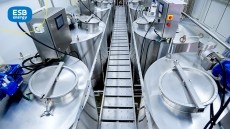Fall in line

You would rather send your child off to work in a food factory than on a construction site, wouldn't you? Of course you would. Construction sites are dangerous places. All those injuries.
But according to the latest Health and Safety Executive (HSE) statistics, you would be making a mistake. Food manufacture is the UK's fourth most dangerous industry to work in, beaten only by recycling, land transport, and sewage and refuse disposal. If you look at all reportable injuries that required more than three days off work and other major injuries, then in 2009/10 a quarter of all manufacturing injuries occurred in the food and drink industries. Some 1,400 injuries per 100,000 workers.
The construction industry actually comes tenth down the list, with an injury rate on a par with the average for all manufacturing industry of 750 injuries per 100,000 workers. And if you want your child to work in a really safe place, then send them to school. In 2009/10 education was the least dangerous place to work, with just 250 injuries per 100,000 workers.
But the good news is that injury rates in food and beverage industries have been falling and are continuing to do so. The overall picture is pretty good, says Richard Morgan, head of food and drink manufacture at the HSE.
"Over the last six years the reportable injury rate for food production alone has dropped 33%. For beverages, it has dropped 32%, virtually the same. And if we look at food and drink since the early 1990s, then the injury rate for them combined has dropped by just over 50%. The food industry has done extremely well in addressing these problems. The short-term trend is good. The long-term trend is good. Plainly, the industry is moving in the right direction."
But the HSE and the food industry are not sitting on their statistical laurels. The HSE, in partnership with the Food and Drink Federation and the trade unions, has recently revised its five-year Common Strategy for Food and Drink.
This will sit alongside a new, revised version of the free booklet Recipe for safety, which is the core publication of the HSE's Recipe for safety initiative, which was launched in the early 1990s. The booklet outlines the industry's health and safety priorities. Due out in April, the revised Recipe for safety will contain a new section on behavioural safety how and why people behave in unsafe ways and what can be done to change their behaviour. This will be based on investigations by the Institution of Occupational Safety and Health (IOSH) into a number of case studies in behavioural safety in the workplace.
It is worth pointing out that, across the whole of the food and drink industry, the injury rates are surprisingly different, says Morgan . "People say food is more dangerous than construction but it depends how you interpret the statistics. Yes, the injury rate in food is higher than in construction, but the injuries are often less severe."
The black spot in the food industry safety statistics is slips, trips and falls. According to Morgan, the accident rate for slips, trips and falls is reducing considerably, but they still account for a quarter of all major injuries in food factories. The issue is people slipping over and breaking arms or cracking skulls or slipping into vessels or falling off ladders or tanks.
"It is one of the characteristics of the industry that the slips not so much the trips have always been and still remain a big issue."
The elephant in the room
So the overall numbers of accidents and injuries are continuing to fall in the food industry. But the elephant in the room is stress, says Morgan. The difficulty is in determining, when workers are off with stress, how much of the stress is related to the workplace and how much is a result of the home environment. But the HSE approach, Morgan says, is that if you have got good management in place then this is will reduce the cases of stress in the workplace.
"We treat stress largely as a management issue," he says. "If you are not overworking your workers, if you are treating them right and if there is a good relationship with management, then you are going to be helping ease the stress on workers."
The HSE liaises with IOSH's food and drink industry group. And one of the topics it has been discussing recently is behavioural safety issues. Once you've put all the guards on your machines, once you've done all your risk assessments, why are food factories still getting accidents?
The reason is plainly the way people behave, says Morgan. "We have got to start looking at why human beings do things the way they do, and why they make mistakes in the way they do." So the food industry and the HSE are looking at behavioural programmes and how to try to avoid accidents caused by people's behaviour.
Neil Catton is chairman of the food and drink group at IOSH. He is also director of health and safety at the Shropshire Group, supplier of salad and vegetable crops. IOSH is helping rewrite and update Recipe for safety to focus on behavioural safety. Behavioural safety is all about the actions of people and why they do what they do, says Catton. "The traditional approach to safety of 'fix this floor tile ' or 'put a guard on this machine' only takes you so far. Beyond that, you have to start focusing on the behaviour of people.
"At IOSH we have looked at a number of behavioural safety schemes that have been implemented across the food industry what has worked, and what hasn't. And we are working with the HSE to include it in the new rewrite of the Recipe for safety."
The behavioural factor that seems to have the most impact is a greater level of workforce involvement, says Catton. "In a lot of the schemes we studied, greater workforce involvement has proven to really build up the understanding and the ownership of safety. Supplementary to that is giving people greater empowerment in the workplace to deal with things, to challenge things."
The key message, says Catton, is that some of these simple procedures and techniques and ways of working really do bring a lot of benefit at low cost. "I work in a big company and we haven't spent a lot of money on behavioural safety programmes, but the results have been really spectacular. We have been implementing behavioural safety for two years now and we have seen a 40% drop in accidents."
A positive behaviour culture is absolutely important, believes Neal Stone, director of policy and communication at the British Safety Council. You can have the best systems in the world, train competent people. But if you don't get the behaviour right, if you don't have leadership from the top, if you don't have all the workforce involved, then you will never be successful in effectively controlling the risks of injury and ill health in the workplace, he says.
"Everybody has responsibility for health and safety. The Health and Safety at Work Act puts responsibilities and duties on every employee not just managers to ensure not just their own health and safety but that of those affected by their work activities. There is an individual responsibility here, which can get overlooked."
But behind the imminent revisions of the HSE's Common Strategy and the Recipe for safety there has been increased activity in sharing best practice in safety and benchmarking, says James Marquette, competitiveness executive at the Food and Drink Federation (FDF). "Ten years ago businesses were fairly competitive on these sorts of issues. But now they have opened up and everyone wants to prevent accidents and injuries, regardless of whether it's in their business or in somebody else's business."
Sharing best practice can be as simple as having un-minuted round-table talks within the FDF about the types of accidents and injuries that companies have had, how they have overcome them and what they have put in their place, says Marquette. "A member may have a problem and ask what others can suggest. We provide an information service for companies so that the outcomes of our health and safety committee meetings will get fed to our members via email."
Benchmarking is literally benchmarking the statistics and looking at the areas and how they change, says Marquette. "The idea is to use that information to establish how a company updates its health and safety policies. So, if they are seeing more slips and trips one year then they may need to focus on changing the floor layout of where they are working, for example.
"With the updating of the Common Strategy and the Recipe for safety, our ambition is to reduce the total injury rate for food and drink manufacturing so that it is below the manufacturing average."
So what should your factory's target accident rate be?
"Your aspirational target should be zero. What else can it be?" says Catton at IOSH. "What we should seek to do is bring things down year-on-year and when things do go wrong make sure people learn from it so that it doesn't happen again. Keep learning. Keep improving. Work in partnership with your workforce to keep driving the accident rate down."














